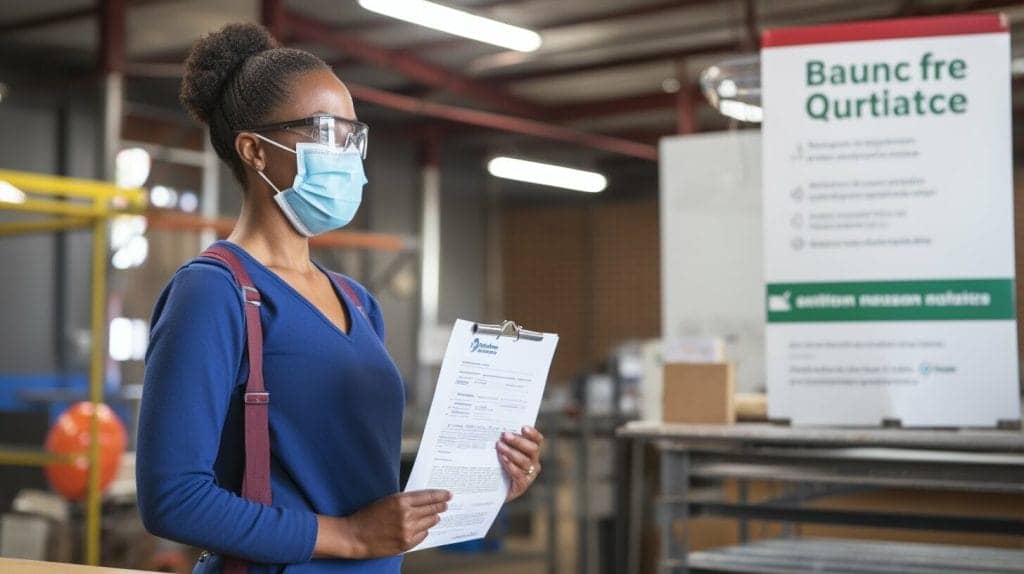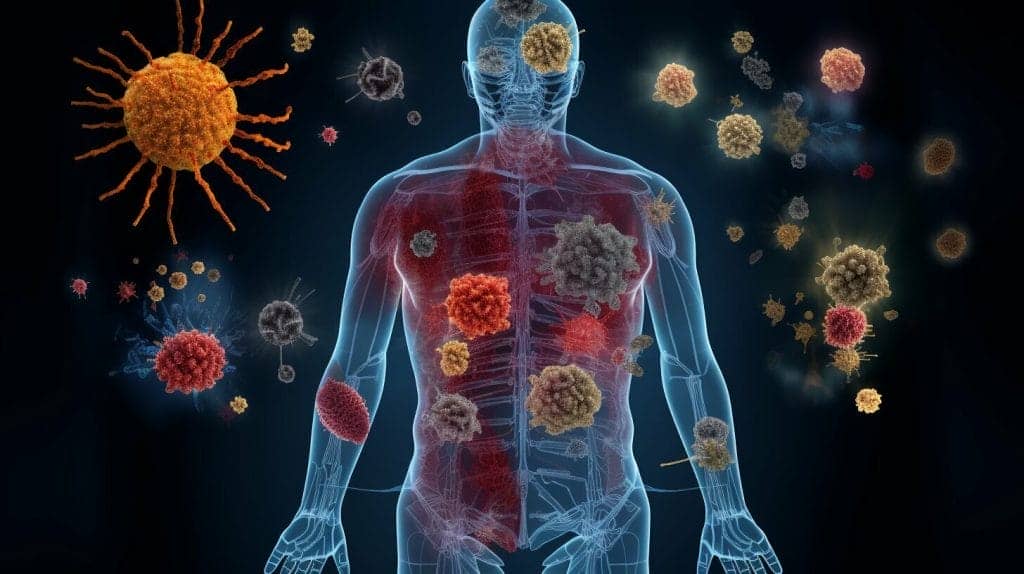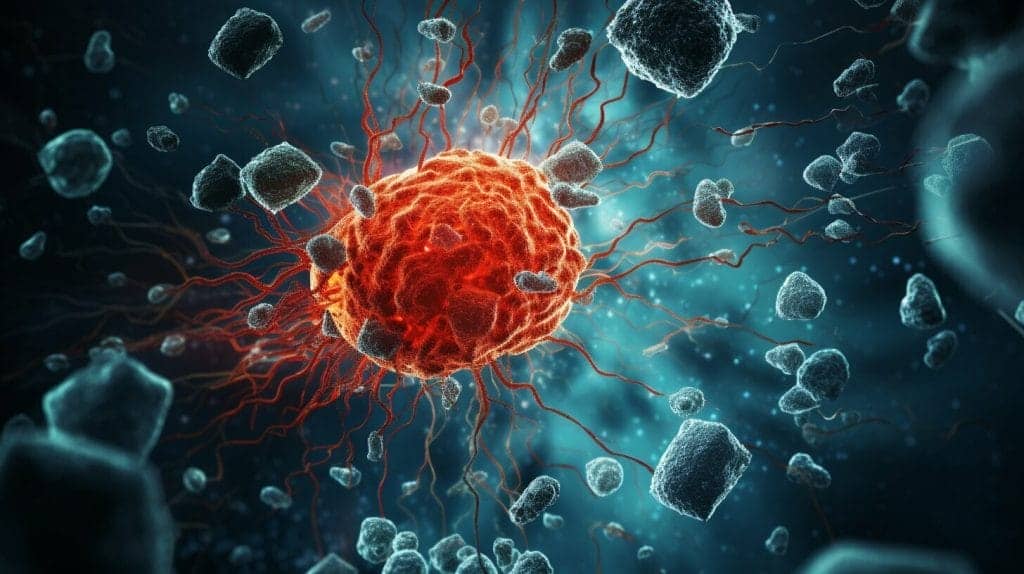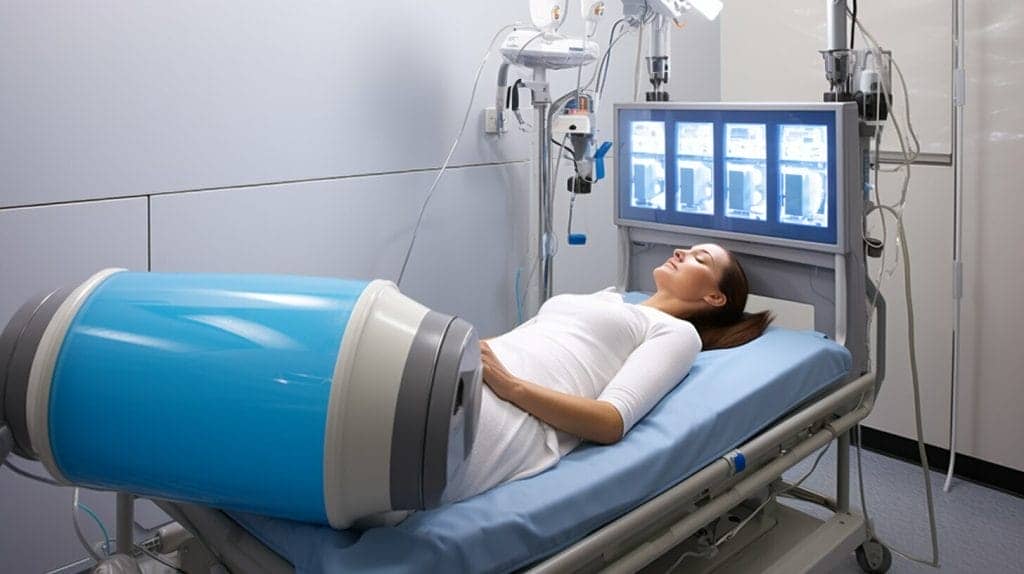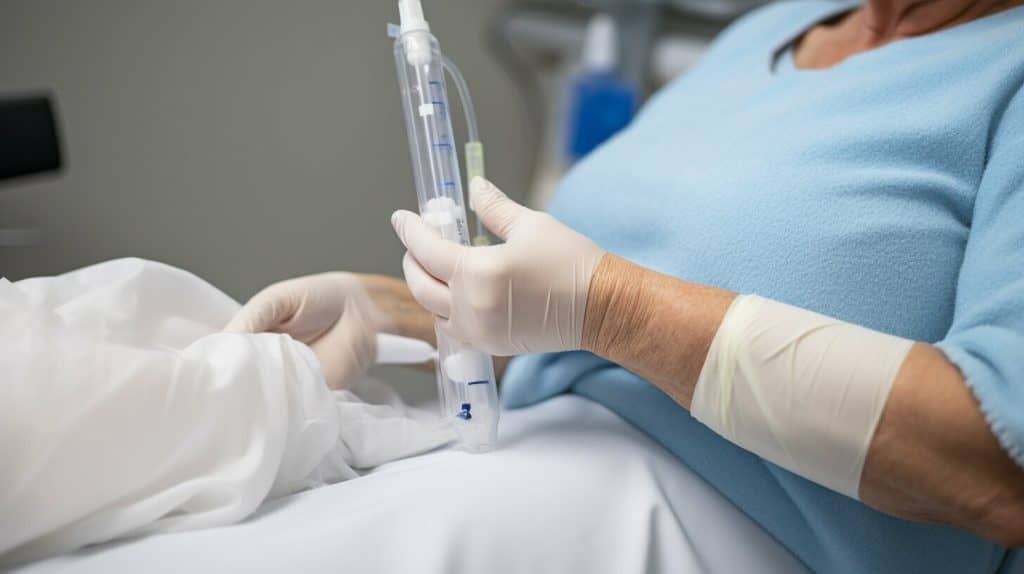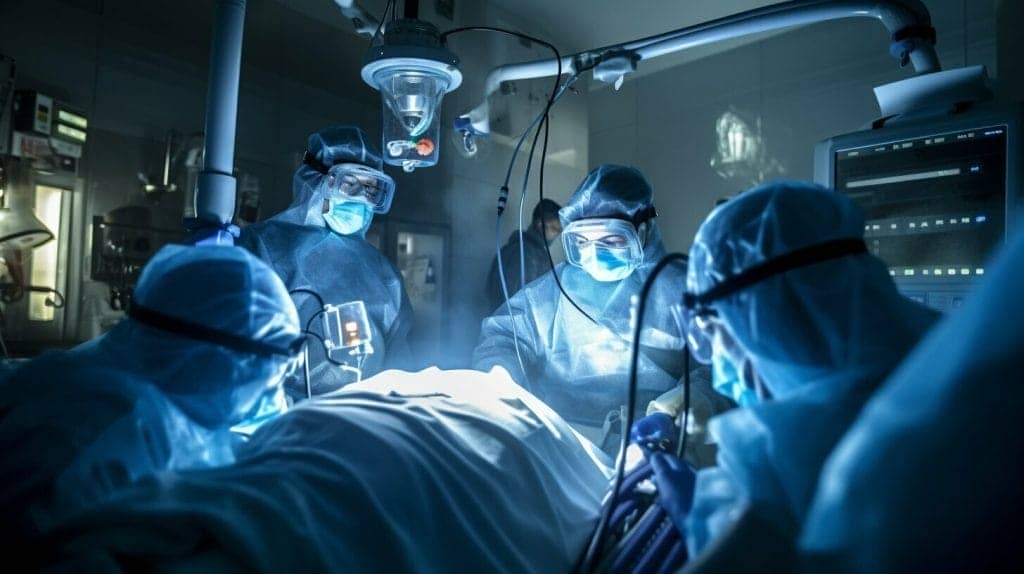The COVID-19 pandemic has brought unprecedented changes to our daily lives, including how we work. For those who have tested positive for COVID-19, the question of when they can safely return to work becomes a crucial one. As the virus continues to spread, it’s essential to take precautions to protect yourself and those around you.
This article will provide an overview of the factors to consider when returning to work after COVID-19, including the typical recovery timeline, post-COVID work restrictions and protocols, and practical tips for a safe return to the workplace. Additionally, it will discuss the integrative medicine approach used by Oasis Medical Institute, a prominent medical facility in Tijuana, MX, and offer advice from medical experts on navigating work-related challenges.
Key Takeaways:
- Returning to work after COVID-19 recovery requires careful consideration of medical advice and workplace protocols.
- Employers have a responsibility to create a safe work environment for employees returning after COVID-19.
- Open communication with employers and colleagues can help manage potential challenges and promote a supportive work environment.
Understanding COVID-19 Recovery Timeline
After contracting COVID-19, it is important to follow medical advice and guidelines during the recovery process. The recovery timeline can vary from person to person, but in general, those who had mild to moderate symptoms can return to work after a minimum of 10 days from the onset of symptoms, provided they have been fever-free for 24 hours without the use of fever-reducing medications and other symptoms have improved. However, those who have severe or critical symptoms may require a longer recovery period and should consult with their healthcare provider.
It is also important to note that individuals who have been in close contact with someone who has tested positive for COVID-19 should follow quarantine guidelines and refrain from returning to work until the recommended isolation period has passed and they have not developed any symptoms.
Post-COVID Work Restrictions and Protocols
Returning to work after COVID-19 may require individuals to adhere to certain restrictions and protocols to ensure the safety of themselves and their coworkers. These measures are typically put in place by employers or workplace health and safety officials and may vary depending on the industry and workplace.
Common post-COVID work restrictions that may be implemented include social distancing measures, such as maintaining a minimum distance of six feet from others, and restrictions on large gatherings or meetings. Employers may also require the use of personal protective equipment (PPE), such as masks or gloves, and may provide hand sanitizing stations throughout the workplace.
Enhanced hygiene practices may also be enforced, such as frequent hand washing or sanitizing, and regular cleaning of shared areas or surfaces. Additionally, workplaces may implement screening measures, such as temperature checks or health assessments, to identify individuals who may be exhibiting symptoms of COVID-19.
It is important for individuals returning to work after COVID-19 to be familiar with these restrictions and protocols and to follow them accordingly. By adhering to these measures, individuals can help minimize the risk of transmission and promote a safe work environment for themselves and their coworkers.
Returning to Work Safely: Precautions and Considerations
Returning to work after recovering from COVID-19 requires careful consideration and planning. Individuals should take necessary precautions to protect themselves and others in the workplace. Here are some tips to ensure a safe transition back to work:
- Monitor Symptoms: Individuals should monitor their symptoms and follow healthcare provider’s guidance on returning to work post-COVID-19.
- Consult with Healthcare Professionals: It is recommended to speak with a healthcare provider before returning to work to ensure that the individual is fully recovered and ready to rejoin the workforce.
- Communicate with Employers: It is important to communicate with employers about any concerns and necessary accommodations. Employers may have specific policies and guidelines for employees returning to work after COVID-19.
- Follow Workplace Restrictions and Protocols: Workplaces may have restrictions and protocols in place to ensure safety in the workplace. These may include measures such as social distancing, mask-wearing, and increased hygiene practices.
- Take it Slow: Individuals should take it slow when returning to work and not rush into full-time hours immediately. This can help prevent any setbacks in recovery.
Holistic Treatments at Oasis Medical Institute
Oasis Medical Institute, located in Tijuana, Mexico, is renowned for its integrative approach to COVID-19 treatment. This facility under the guidance of medical director Dr. Francisco Contreras MD focuses on treating the whole person, not just the symptoms of the disease.
“We pride ourselves on offering personalized, compassionate care to each patient, with a focus on cutting-edge medical treatments and complementary therapies,” says Dr. Contreras.
At Oasis Medical Institute, patients recovering from COVID-19 can expect to receive a combination of traditional medical treatments and holistic therapies, such as nutritional counseling, acupuncture, and mindfulness practices. This integrative approach can help to improve overall well-being and support a faster, more complete recovery.
Integrative Medicine for COVID-19
At Oasis Medical Institute, an integrative approach to COVID-19 treatment is provided. This approach combines conventional medical treatments with complementary therapies that have been shown to support the immune system and expedite recovery.
Dr. Francisco Contreras and his team of medical experts provide a comprehensive treatment program that includes nutritional therapy, acupuncture, ozone therapy, and other holistic treatments.
Nutritional Therapy
Nutritional therapy plays a crucial role in the recovery process for COVID-19 patients. At Oasis Medical Institute, patients receive personalized nutrition plans that are designed to support their immune system and promote healing.
These plans include a variety of nutrient-dense foods, vitamins, and supplements that have been shown to support immune function and reduce inflammation. Patients also receive guidance on how to prepare and consume these foods for maximum benefit.
Acupuncture
Acupuncture is a form of traditional Chinese medicine that involves the insertion of thin needles into specific points on the body.
At Oasis Medical Institute, acupuncture is used as a complementary therapy for COVID-19 patients. It has been shown to reduce inflammation, alleviate pain, and promote relaxation, all of which can support the healing process.
Ozone Therapy
Ozone therapy is a form of complementary medicine that involves the administration of ozone gas into the body. This therapy has been shown to support immune function by increasing the activity of white blood cells and improving circulation.
At Oasis Medical Institute, ozone therapy is used as a complementary treatment for COVID-19 patients. It is administered in a safe and controlled environment by trained medical professionals.
Booking a Consultation at Oasis Medical Institute
If you’re interested in exploring holistic treatments for COVID-19 at Oasis Medical Institute, booking a consultation is the first step. Led by medical director Dr. Francisco Contreras MD, Oasis offers an integrative approach that combines traditional medical treatments with complementary therapies to support patients’ overall health and well-being.
To schedule a consultation, you can call Oasis Medical Institute at 866-868-1992. Their team will be happy to answer any questions you may have and guide you through the process of booking an appointment.
Safe Return Tips from Medical Experts
Returning to work after recovering from COVID-19 can be a challenging experience. Medical experts recommend taking precautions to minimize the risk of transmission and ensure a safe transition back to the workplace.
Tip 1: Monitor Your Symptoms
It is important to keep track of your symptoms and report any changes to your healthcare provider. If you experience fever, cough, or shortness of breath, do not return to work until you have consulted with your healthcare provider.
Tip 2: Consult with Your Healthcare Provider
Before returning to work, consult with your healthcare provider to ensure that it is safe to do so. They can provide guidance on when it is appropriate to return to work and any necessary precautions that you should take.
Tip 3: Communicate with Your Employer
Discuss any concerns or accommodations that you may need with your employer. They may be able to make adjustments to your work environment to ensure your safety and well-being.
Tip 4: Practice Good Hygiene
Wash your hands frequently with soap and water for at least 20 seconds. Use hand sanitizer when hand washing is not possible. Cover your mouth and nose with a tissue or your elbow when coughing or sneezing.
Tip 5: Wear a Mask
Wear a mask when around others to help prevent the spread of the virus. Make sure your mask covers your nose and mouth and fits snugly against the sides of your face without gaps.
Tip 6: Practice Social Distancing
Maintain a distance of at least six feet from others whenever possible. Avoid crowded spaces and gatherings.
Tip 7: Follow Workplace Protocols
Adhere to any workplace protocols that have been put in place, including enhanced cleaning and disinfection practices, temperature checks, and symptom screenings.
Communicating with Your Employer
Open communication with your employer is crucial when planning to return to work after recovering from COVID-19. It is important to discuss any concerns, accommodations, or necessary adjustments with your employer to ensure a smooth transition back to the workplace.
When preparing to discuss your return to work with your employer, consider the following:
- Be clear about your timeline for returning to work
- Discuss any adjustments or accommodations that may be necessary for you to perform your job duties
- Ask about any changes to workplace policies or protocols that may have been implemented since your absence
- Be prepared to provide documentation from your healthcare provider regarding your recovery and ability to return to work
Remember that your employer has a responsibility to provide a safe working environment for all employees, including those who have recovered from COVID-19. By communicating openly and honestly with your employer, you can help ensure a successful return to work for everyone involved.
Mental and Emotional Well-being Post-COVID
Returning to work after recovering from COVID-19 can be a challenging and stressful experience, both physically and mentally. Many individuals may experience lingering anxiety, stress, or emotional challenges during the transition back to the workplace.
It is important to prioritize mental and emotional well-being during this time. Here are some tips to help manage any challenges:
- Be patient with yourself: Give yourself time to adjust to the new routine and pace of work, and don’t push yourself too hard.
- Stay connected: Reach out to colleagues, friends, or family members for support and social connection.
- Practice self-care: Take time to prioritize self-care activities, such as exercise, meditation, or spending time outdoors.
- Seek professional help: Consider talking to a mental health professional if you are struggling with anxiety, depression, or other emotional challenges.
Remember, it is normal to experience challenges during this time, and seeking help is a sign of strength. By prioritizing mental and emotional well-being, individuals can set themselves up for a successful return to work after COVID-19.
Staying Informed: Updates and Guidelines
As the situation with COVID-19 evolves, it is essential to stay informed about the latest updates and guidelines related to workplace safety. The Centers for Disease Control and Prevention (CDC) and the World Health Organization (WHO) offer reliable and up-to-date information on COVID-19 guidelines, protocols, and recommendations.
Employers should regularly communicate with their employees about any updates or changes in workplace protocols and safety measures related to COVID-19. Employees should also be encouraged to stay informed and follow the latest guidelines to ensure a safe return to work.
Creating a Safe Work Environment
Employers have a responsibility to provide a safe work environment for employees returning after COVID-19. This includes implementing measures such as regular cleaning, proper ventilation, and employee education on safety protocols. Employers can also consider adjusting work schedules and providing flexible work options to accommodate employees who may still be recovering or experiencing lingering symptoms.
It is important for employers to communicate openly and frequently with employees about any updates or changes to workplace safety protocols. This can help promote trust and transparency, as well as ensure that all employees are aware of and following necessary guidelines.
| Measures for a Safe Work Environment: | Benefits: |
|---|---|
| Regular cleaning: Frequent cleaning of high-touch areas such as doorknobs, desks, and shared equipment can help minimize the risk of transmission. | Reduces the risk of transmission and promotes overall workplace hygiene. |
| Proper ventilation: Ensuring that the workplace has adequate ventilation can help minimize the spread of airborne particles. | Improves air quality and reduces the risk of transmission. |
| Employee education: Providing regular education and training on safety protocols can help ensure that all employees are aware of and following necessary guidelines. | Promotes a culture of safety and ensures that all employees are equipped to protect themselves and others. |
By prioritizing the safety and well-being of employees, employers can create a positive and supportive work environment that promotes health and productivity for all.
Navigating Work-Related Challenges
Returning to work after recovering from COVID-19 can present various challenges, both physical and emotional. It is important for individuals to be aware of these challenges and implement strategies to manage them effectively.
Physical Challenges
Some individuals may experience physical challenges as they return to work, such as fatigue, shortness of breath, or muscle weakness. It is important to communicate any ongoing symptoms with healthcare professionals and employers, and to gradually increase physical activity levels to prevent overexertion.
Employers can also support employees by providing flexible work arrangements and making necessary accommodations to ensure a safe and comfortable work environment.
Emotional Challenges
Returning to work after a COVID-19 diagnosis can also present emotional challenges, such as anxiety, stress, or fear of reinfection. It is important for individuals to prioritize self-care and seek support when needed, whether it be from healthcare professionals, employee assistance programs, or trusted colleagues.
Employers can also promote mental health and well-being by offering resources such as counseling services, mindfulness practices, or social support groups.
Overall, navigating work-related challenges after recovering from COVID-19 requires a combination of self-care, open communication with healthcare professionals and employers, and a supportive work environment.
Supporting Coworkers and Promoting Well-being
Returning to work after recovering from COVID-19 can be a challenging and stressful experience for employees, and it is important for coworkers to foster a supportive and inclusive work environment.
One way to support coworkers is to listen to their concerns and offer empathy and encouragement. This can include checking in regularly and asking how they are feeling, as well as offering to help with tasks or projects if needed.
Another way to promote well-being in the workplace is to encourage healthy habits and behaviors. This can include setting up a designated space for employees to practice mindfulness or meditation, promoting regular breaks and healthy snacking options, and offering resources for mental health support.
“We need to be there for each other during these uncertain times and prioritize the well-being of our colleagues.”
By fostering a supportive and inclusive work environment, employees can feel empowered to take care of their health and well-being, and the entire workplace can benefit from a sense of community and shared responsibility.
Conclusion
Returning to work after COVID-19 can be a challenging experience, but taking the necessary precautions and following guidelines can help ease the transition and ensure a safe and healthy workplace. It is important to understand the recovery timeline and any restrictions or protocols that may be in place at your workplace. Communication with your employer is also crucial, as well as taking care of your mental and emotional well-being during this time.
Remember to stay informed about the latest updates and guidelines, and to support your coworkers in creating a safe and inclusive work environment. If you are experiencing any work-related challenges post-COVID, seek support and guidance from medical professionals and your employer. Take these steps to ensure a successful and safe return to work after COVID-19.
FAQ
Q: When can I go back to work after COVID?
A: The timeline for returning to work after COVID-19 can vary depending on individual circumstances and medical advice. It is important to consult with healthcare professionals for guidance on when it is safe to return to work.
Q: What are the post-COVID work restrictions and protocols?
A: Workplaces may have specific restrictions and protocols in place for employees who have recovered from COVID-19. These measures often include social distancing, mask-wearing, and enhanced hygiene practices to ensure a safe work environment.
Q: What precautions and considerations should I take when returning to work?
A: When returning to work after recovering from COVID-19, it is important to monitor symptoms, consult with healthcare professionals, and communicate with your employer about the recovery process. Following guidelines and taking necessary precautions will help ensure a safe transition back to the workplace.
Q: What is Oasis Medical Institute’s approach to treating COVID-19?
A: Oasis Medical Institute in Tijuana, MX, takes an integrative approach to COVID-19 treatment. With medical director Dr. Francisco Contreras MD, they offer holistic treatments that combine traditional medicine with complementary therapies.
Q: How can I book a consultation at Oasis Medical Institute?
A: To book a consultation at Oasis Medical Institute for COVID-19 treatment, call 866-868-1992. Their team will provide further information and assist you in scheduling an appointment.
Q: What are some safe return tips from medical experts?
A: Medical experts recommend taking precautions such as minimizing close contact, practicing good hygiene, and following workplace safety protocols when returning to work after recovering from COVID-19. These tips help reduce the risk of transmission and ensure a safe return to the workplace.
Q: How can I communicate with my employer about returning to work after COVID-19?
A: It is important to maintain open communication with your employer when planning to return to work after COVID-19. Discuss any concerns, accommodations, or necessary adjustments with your employer to ensure a smooth transition back to the workplace.
Q: What can I do to support my mental and emotional well-being post-COVID?
A: Managing any lingering anxiety, stress, or emotional challenges that may arise during the return to work process is essential. Practicing self-care, seeking support from loved ones, and considering professional help are effective ways to support your mental and emotional well-being.
Q: How can I stay informed about updates and guidelines related to COVID-19?
A: Stay informed about the latest updates and guidelines related to COVID-19 by regularly checking trusted sources for reliable information. This will help you stay up-to-date on workplace protocols and safety measures.
Q: What can employers do to create a safe work environment?
A: Employers have a responsibility to create a safe work environment for employees returning after COVID-19. This includes implementing measures such as regular cleaning, proper ventilation, and employee education on safety protocols.
Q: How can I navigate work-related challenges when returning after COVID-19?
A: Returning to work after recovering from COVID-19 may present challenges. To navigate these challenges effectively, prioritize self-care, communicate with your employer, and seek support from colleagues or professional resources when needed.
Q: How can I support coworkers who have returned to work after COVID-19?
A: Supporting coworkers who have returned to work after COVID-19 is important. Foster a supportive and inclusive work environment by showing empathy, offering assistance when needed, and promoting overall well-being for all employees.
Dr. Francisco Contreras, MD is a renowned integrative medical physician with over 20 years of dedicated experience in the field of integrative medicine. As the Medical Director of the Oasis of Hope Hospital in Tijuana, Mexico, he has pioneered innovative treatments and integrative approaches that have been recognized globally for the treatment of cancer, Lyme Disease, Mold Toxicity, and chronic disease using alternative treatment modalities. Dr. Contreras holds a medical degree from the Autonomous University of Mexico in Toluca, and speciality in surgical oncology from the University of Vienna in Austria.
Under his visionary leadership, the Oasis of Hope Hospital has emerged as a leading institution, renowned for its innovative treatments and patient-centric approach for treating cancer, Lyme Disease, Mold Toxicity, Long-Haul COVID, and chronic disease. The hospital, under Dr. Contreras's guidance, has successfully treated thousands of patients, many of whom traveled from different parts of the world, seeking the unique and compassionate care the institution offers.
Dr. Contreras has contributed to numerous research papers, articles, and medical journals, solidifying his expertise in the realm of integrative medicine. His commitment to patient care and evidence-based treatments has earned him a reputation for trustworthiness and excellence. Dr. Contreras is frequently invited to speak at international conferences and has been featured on CNN, WMAR2 News, KGUN9 News, Tyent USA, and various others for his groundbreaking work. His dedication to the medical community and his patients is unwavering, making him a leading authority in the field.
Contreras has authored and co-authored several books concerning integrative therapy, cancer, Lyme Disease and heart disease prevention and chronic illness, including "The Art Science of Undermining Cancer", "The Art & Science of Undermining Cancer: Strategies to Slow, Control, Reverse", "Look Younger, Live Longer: 10 Steps to Reverse Aging and Live a Vibrant Life", "The Coming Cancer Cure Your Guide to effective alternative, conventional and integrative therapies", "Hope Medicine & Healing", "Health in the 21st Century: Will Doctors Survive?", "Healthy Heart: An alternative guide to a healthy heart", “The Hope of Living Cancer Free”, “Hope Of Living Long And Well: 10 Steps to look younger, feel better, live longer” “Fighting Cancer 20 Different Ways”, "50 Critical Cancer Answers: Your Personal Battle Plan for Beating Cancer", "To Beat . . . Or Not to Beat?", and “Dismantling Cancer.”

